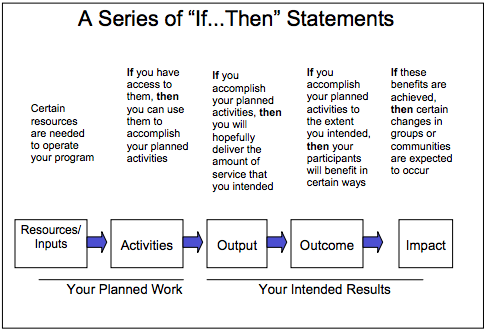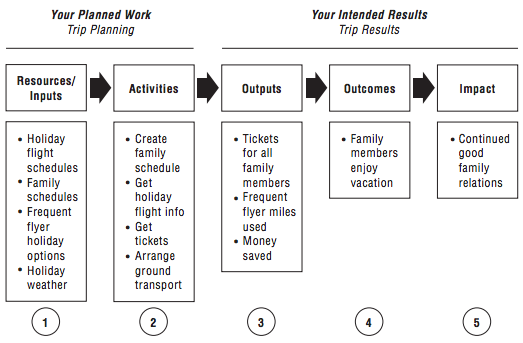Logic model
Logic models are visual representations of a program’s goals, assumptions, activities, and resources. They can help with figuring out and articulating the internal logic of a program, or what the program seeks to achieve and what it will take to get there. It is also useful for planning program evaluation, as it lists the most important processes and outcomes of the program.
A logic model should fit on one page, and it generally includes inputs, activities, outputs, outcomes, impacts, external factors, and assumptions.
- Inputs (also sometimes called resources) are all of the resources needed to operate a program, often including funding, staff time and expertise, existing collaborative bodies, office space and resources, printing and utilities, etc.
- Activities are what will be done in the program. They should match what is listed in the scope of work or work plan, if there is one.
- Outputs are the products that will directly result from your activities. They often include deliverables listed in the scope of work or work plan, new policies, attendance sheets, completed worksheets, posters, social media messages, etc.
- Outcomes are the changes you want to occur as a result of the program. There can be short-, medium-, and long-term outcomes. There is no agreed-upon time frame for outcomes, but a general guideline, short-term outcomes usually occur 3 months to a year after the program, medium-term outcomes can occur 6 months-2 years after a program, and long-term outcomes happen 2 or more years after a program.
- Impacts are the larger and broader changes that you hope your program will contribute to in the community or society.
- External factors are factors that are beyond the control of your program that affect the context in which the program is implemented, such as the economy, local or regional politics, funder stability, other programs that support or hinder your efforts, etc.
- Assumptions are statements about the way you think the program will work. For example, a program’s logic might assume that there is stakeholder buy-in, that stakeholders have power to change their communities, that trainings will effectively increase staff’s capacity, etc.
Below is a figure from the CDC’s Developing and Using a Logic Model that explains the relationships between each categories.
The Kellogg Foundation’s Logic Model Development Guide gives this sample logic model to illustrate the types of entries that could go in each category (although external factors and assumptions are missing).
Evaluation
Logic models can also help inform evaluation plans. The resources/inputs, activities, and outputs columns provide a basis for process (formative) evaluation, and the outcomes and impacts should form the basis of the outcome (summative) evaluation. If any component of your logic model does not occur as planned, it can affect components of all of the following columns. Using the vacation example above, if not everyone gets tickets, then not all family members will have tickets, not all family members will enjoy the vacation, and good family relations may not continue for all family members. Thus, logic models can not only guide evaluation questions, but can also help provide explanations if desired changes are not achieved.
Many of the resources listed below provide more details about how logic models can inform evaluation.
Additional resources
- PreventConnect’s eLearning course and web conference recording on using logic models for planning primary prevention programs
- VetoViolence, by the CDC, has the EvaluACTION toolkit, which includes a logic model builder and evaluation plan builder.
- The Kellogg Foundation’s Logic Model Development Guide
- The CDC’s Developing and Using a Logic Model and A Guide on Logic Model Development for CDC’s Prevention Research Centers
- Jodie Drisko, MSPH of the Health Disparities Grant Program’s powerpoint presentation outlining how to use a logic model to plan prevention work
- United Way’s Construct a Logic Model for Your Program
- Designing Projects and Project Evaluations Using The Logical Framework Approach
- Bureau of Justice Assistance’s Developing and Working with Program Logic Models
- Connie C. Schmitz and Beverly A. Parson’s Everything You Wanted to Know About Logic Models But Were Afraid to Ask
- Harvard Family Research Project’s Learning from Logic Models: An Example of a Family/School Partnership Program
- University of Wisconsin Cooperative Extension’s Logic Model Tools and Successfully Enhancing Program Performance Through Logic Model
